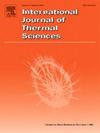Transition and heat transfer in a water filled cubic cavity with convectively heated sidewalls
IF 4.9
2区 工程技术
Q1 ENGINEERING, MECHANICAL
International Journal of Thermal Sciences
Pub Date : 2025-04-03
DOI:10.1016/j.ijthermalsci.2025.109913
引用次数: 0
Abstract
Transition and heat transfer in a water filled cubic cavity with convectively heated sidewalls are investigated using three dimensional numerical simulations due to the practical significance in environment and industry. The numerical study is performed for a range of Rayleigh number (Ra) from 100 to 5 × 108 for which the working fluid is water (Pr = 7.74). Such a range of Rayleigh numbers shows a complex transition route to chaos of natural convection involving successive bifurcations. The first pitchfork bifurcation occurs under steady convection regime between Ra = 3.3 × 104 and Ra = 3.4 × 104 based on the topologic invariant relation. Further, more pitchfork bifurcations happen as Ra is increased. Additionally, a Hopf bifurcation occurs between Ra = 2.6 × 109 and Ra = 2.7 × 109 at which natural convection becomes periodic. Further bifurcations may also occur between Ra = 3.2 × 109 and Ra = 3.3 × 109 from periodic to period doubling state and between Ra = 3.3 × 109 and Ra = 3.4 × 109 from period doubling to quasi-periodic state. For a large Rayleigh number of Ra≥3.9 × 109, natural convection becomes chaotic. To characterize the transition to chaos, topologic invariant relation, spectrum, attractor, maximum Lyapunov exponent, and fractal dimension are adopted. In addition, heat transfer is analyzed and scaled under different regimes.
具有对流加热侧壁的充满水的立方腔内的过渡和传热
本文采用三维数值模拟方法研究了具有对流加热侧壁的充水立方腔内的相变和换热问题,具有重要的环境和工业应用价值。对工作流体为水(Pr = 7.74)的瑞利数(Ra)范围从100到5 × 108进行了数值研究。这样的瑞利数范围显示了涉及连续分岔的自然对流到混沌的复杂过渡路线。基于拓扑不变关系,第一次干草叉分叉发生在Ra = 3.3 × 104和Ra = 3.4 × 104之间的定常对流区。此外,随着Ra的增加,会发生更多的干草叉分叉。此外,在Ra = 2.6 × 109和Ra = 2.7 × 109之间发生Hopf分岔,此时自然对流成为周期性的。在从周期态到倍周期态的Ra = 3.2 × 109和Ra = 3.3 × 109之间以及从倍周期态到准周期态的Ra = 3.3 × 109和Ra = 3.4 × 109之间也可能出现进一步的分岔。当Ra≥3.9 × 109的瑞利数较大时,自然对流变得混沌。采用拓扑不变关系、谱、吸引子、最大李雅普诺夫指数和分形维数来表征混沌过渡。此外,还对不同工况下的传热进行了分析和计算。
本文章由计算机程序翻译,如有差异,请以英文原文为准。
求助全文
约1分钟内获得全文
求助全文
来源期刊

International Journal of Thermal Sciences
工程技术-工程:机械
CiteScore
8.10
自引率
11.10%
发文量
531
审稿时长
55 days
期刊介绍:
The International Journal of Thermal Sciences is a journal devoted to the publication of fundamental studies on the physics of transfer processes in general, with an emphasis on thermal aspects and also applied research on various processes, energy systems and the environment. Articles are published in English and French, and are subject to peer review.
The fundamental subjects considered within the scope of the journal are:
* Heat and relevant mass transfer at all scales (nano, micro and macro) and in all types of material (heterogeneous, composites, biological,...) and fluid flow
* Forced, natural or mixed convection in reactive or non-reactive media
* Single or multi–phase fluid flow with or without phase change
* Near–and far–field radiative heat transfer
* Combined modes of heat transfer in complex systems (for example, plasmas, biological, geological,...)
* Multiscale modelling
The applied research topics include:
* Heat exchangers, heat pipes, cooling processes
* Transport phenomena taking place in industrial processes (chemical, food and agricultural, metallurgical, space and aeronautical, automobile industries)
* Nano–and micro–technology for energy, space, biosystems and devices
* Heat transport analysis in advanced systems
* Impact of energy–related processes on environment, and emerging energy systems
The study of thermophysical properties of materials and fluids, thermal measurement techniques, inverse methods, and the developments of experimental methods are within the scope of the International Journal of Thermal Sciences which also covers the modelling, and numerical methods applied to thermal transfer.
 求助内容:
求助内容: 应助结果提醒方式:
应助结果提醒方式:


